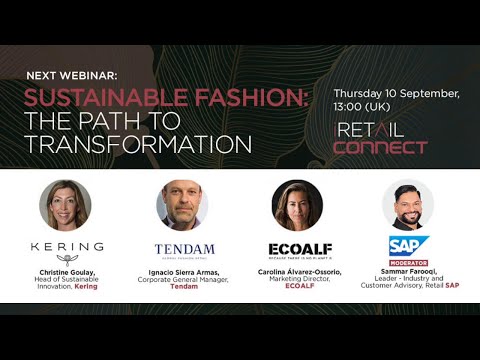Mother Nature is priceless, yet humans seem to be hell-bent on destroying our most precious asset. The need for urgent action has never been greater.
Human-induced climate change is already impacting our daily lives, but we keep burning fossil fuels, cutting forests, depleting nature’s stocks, and polluting our land and water. The scientific data is overwhelming, yet according to a recent UN report the world once again has failed to meet a single target to stop the destruction of nature.
But there are signs of progress and elements of hope in the world of fashion retail world, which happens to be the second most polluting industry on the planet. Gary Thatcher, CEO and co-founder of The Retail Summit, recently hosted more than 100 research calls with the retail community and reports that there was hardly a conversation where sustainability was not a top priority.
During a discussion on sustainable fashion sponsored by SAP as part of the summit, top executives shared insights and exciting new developments. Sammar Farooqi, industries leader for Retail and Consumer at SAP, chaired the webinar.

Environmental Profit and Loss at Kering
Christine Goulay is head of Sustainable Innovation at Kering, a company that manages renowned fashion houses, including Gucci and Saint Laurent. She put a pause to the conversation while everyone pondered her question about the amount we would owe Mother Nature for the environmental impact caused by business.
Goulay considers Kering lucky that its chairman and CEO, François-Henri Pinault, believes that it is not only the moral responsibility of a company to behave responsibly when doing business, but it is also important for long-term sustainability.
“In the world of luxury, we source high-quality raw materials like cashmere, wool, and leather from natural ecosystems, so we have strong ties to those ecosystems,” she said. “We need to preserve that biodiversity for the long term.”
Goulay went on to explain that Kering developed a capital accounting methodology called Environmental Profit and Loss (EP&L), which measures carbon emissions, water consumption, air and water pollution, land use, and waste production along the entire supply chain. This makes the various environmental impacts of the group’s activities visible, comparable, and quantifiable, and enables a conversion into monetary values reflecting the use of natural resources.
“It’s a great tool because it allows us to speak about our environmental impact in financial terms,” she shared. “By converting into monetary figures, we better understand the link between impact and nature. That’s still the language businesspeople are using. Only when we convert our impact into monetary figures can we understand the true impact on nature.”
Kering uses the EP&L methodology to guide its sustainability strategy, improve its processes and supply sources, and choose the best technologies. Of great importance to Goulay is the connection between employee performance and key performance indicators (KPIs).
At Kering, a portion of the bonus of top management is based on their sustainability achievements. It is important for people to understand that profitability is connected to sustainability.
For EcoAlf, There Is No Planet B
EcoAlf was created 10 years ago when avant-garde Spanish entrepreneur Javier Goyeneche decided to create a truly sustainable fashion brand. He chose to stop using natural resources in order to preserve them for the next generation and instead produce recycled products with the same quality and design as a high-end fashion brand.
Today EcoAlf specializes in lifestyle outerwear, footwear, and accessories made from recycled materials. EcoAlf collaborates with partners around the world to reuse plastic waste from the oceans and close the circular loop by reinserting it into the production cycle.
“We do what we do because there is no planet B,” said Carolina Álvarez-Ossorio, marketing director at EcoAlf. “Fashion is more than just looking good; it’s about doing what is right. We also educate consumers to help them understand what sustainability means across the entire supply chain.”
EcoAlf is keenly aware that an enterprise is not completely circular until you close the loop, so the company is constantly trying to measure and improve its use of materials and the energy in the production cycle. It is also piloting a program to collect clothing in stores for recycling so it does not end up in landfill.
“We know that 90 percent of the impact occurs at the design stage of a product, so we strive to use low-impact materials and the least amount of processes,” Álvarez-Ossorio shared. “We invest in high-quality and innovation to ensure a long life cycle for our garments, and we help our suppliers to become more energy efficient.”
One example of EcoAlf’s ingenious projects is the use of photocatalytic treatment. Alvarez-Ossorio explains this technology as basically a coating that kills 99.9 percent of viruses and bacteria while helping to eliminate 40 percent of air pollution around the person wearing the item.
“The use of photocatalysis is prevalent in other industries such as hospitality or architecture but hasn’t been applied to textiles yet” she said. “We’re committed to this project, which is part of iSCAPE, the European Union initiative to combat air pollution in European cities.”
Tendam’s Long-Term Commitments
Fashion is an industry where commercial and critical success can be short-lived. Longevity is the result of much hard work, such as attracting new customers while keeping old ones and managing highly complex supply chains.
Ignacio Sierra Armas is corporate general manager at Tendam, a global fashion retailer established in Spain in 1888.
“As a company that has been around for 140 years, we realize that our continuity depends on our relevance,” said Sierra Armas, who is also the president of the European Branded Clothing Alliance (EBCA). “This means doing what’s right for the customer day in and day out, year after year.”
Sierra Armas also believes in doing what’s right for the planet: “We’re in a big industry that has a global impact. We’re creating jobs; we’re creating wealth. But as a European company, we also act as a change agent for less developed countries. We understand that long-term commitments and partnerships are essential.”
He went on to cite the example of the current COVID-19 pandemic. Tendam’s priority was to work closely with suppliers and demonstrate commitment to future projects.
“We strive to prepare our suppliers for future demand, so they can prepare themselves to meet it,” Sierra Armas said. “In spite of the crisis, we need to think long-term. It’s not about replacing products with low cost and low quality, but about demonstrating the worth of fashion that lasts. We have to find a balance between long-lasting quality and the excitement of new fashion.”
For Tendam, this is a time to refocus on supply chain excellence. Sustainable practices are top of mind. The company was able to reduce 30 percent of its CO2 emissions in just one year, while deriving 80 percent of its energy from renewable sources. And water usage decreased dramatically by 90 percent when the company started treating denim with laser technology rather than washing the fabric in the traditional way.
According to Sierra Armas, “We can only be profitable if we are sustainable.”
A healthy, circular way of living requires a shift in mindset. As Kering, EcoAlf, and Tendam demonstrate, it requires continuous effort, a cultural effort, and a massive effort to reduce waste and change our perception of consumption. But every step we take now will be worth one less dollar we owe Mother Nature tomorrow.
Watch a recording of the discussion here.
Follow me on Twitter: @magyarj



